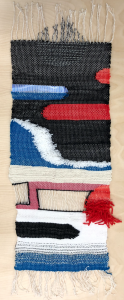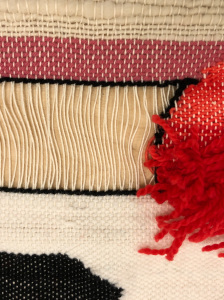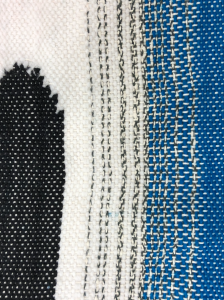Final Weaving – Michael Powell

Final Weave in Full.
Intention
In both my sample and final weaving I sought to explore the techniques that allow me to manipulate the material as a means to explore soft texture and hard geometry. My weavings continue to play with high contrast, as well as more subtle detailing as a means to explore and express the process of making these shapes. Equal stress was placed on an understanding of weaving as fine art and functional craft that benefited from a process of experimentation and problem solving in order for the piece to manifest. While the piece does not have a conceptual, or theoretical grounding, it is rooted in an affinity with geometry, form, order, and pattern making that can develop new languages of material through an experimental hands on process.
Process
I began my process by sketching out a number of patterns, forms, and blocking strategies stemming from my sample weaving (see at bottom). I noticed an underlying interest of gradation, and repetition in my sample and worked to further develop these notions. My original plan was to create a piece that was composed of five equally sized squares that each approached their relationship to the warp or the weft in a different manner. Once I began my weaving, I became interested in the subtle differences in color that I could use as the flat base of the piece that would stretch around each unique square. The remaining colors were selected as I made each square, but were selected for their high contrast to the white base, as well as any other colors they may have been paired with in their same 8″x8″ bounds.
In order to make the forms themselves, I would draw the outline of the form on the “neutral” warp allowing me to see where each weft should be headed. While I explored a couple of techniques to create texture, I stuck with the rya knot that I briefly explored in the sample. I also elaborated on the exposure of weft which was described as a “window” during review.
As I went through the process of making each square, I adapted my original plan. I ran out of warp half way through the weaving, causing me to alter my pattern. This instance gave me the opportunity to play with an expression of this happening, as well as treat the support of the warp as an artistic element as well.
Details of the textures from my final weaving follow.
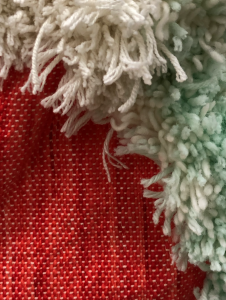
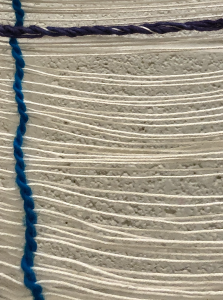

Learning
Most of the gestures and decisions made can be traced back to the experimentation within my sample weave. I was able to develop a strategy to create uniform, symmetrical shapes in my more exploratory work that gave me the confidence to pursue more rigid geometries in the final weaving. Even with this practice, I pushed the limits of span and density within the final weave that resulted in a series of unwanted distortions. While some peers found these distortions to be pleasant, it went against the vision I had. If I were to go back to this work I may try to further develop the frame as a means to stretch the piece more uniformly.
I have developed a huge respect for the work that was completed by my peers, as well as the work completed by other practitioners. The amount of patience and intellect that is required to go into the crafting of a piece is easily, and wrongfully, overlooked.
Images of the details and entirety of my sample weaving are below.
